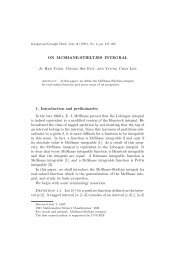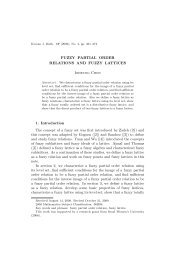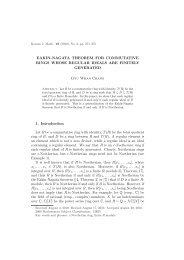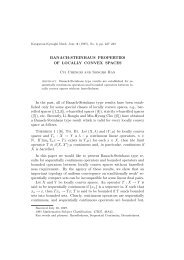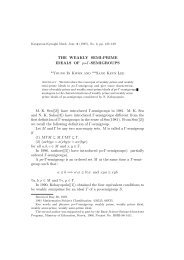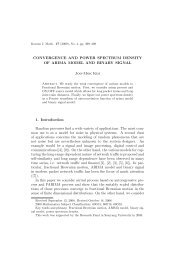G-FUZZY EQUIVALENCE RELATIONS GENERATED BY FUZZY ...
G-FUZZY EQUIVALENCE RELATIONS GENERATED BY FUZZY ...
G-FUZZY EQUIVALENCE RELATIONS GENERATED BY FUZZY ...
Create successful ePaper yourself
Turn your PDF publications into a flip-book with our unique Google optimized e-Paper software.
Kangweon-Kyungki Math. Jour. 11 (2003), No. 2, pp. 169–175<br />
G-<strong>FUZZY</strong> <strong>EQUIVALENCE</strong> <strong>RELATIONS</strong><br />
<strong>GENERATED</strong> <strong>BY</strong> <strong>FUZZY</strong> <strong>RELATIONS</strong><br />
Inheung Chon<br />
Abstract. We find a G-fuzzy equivalence relation generated by<br />
the union of two G-fuzzy equivalence relations in a set, find a G-<br />
fuzzy equivalence relation generated by a fuzzy relation in a set, and<br />
find sufficient conditions for the composition µ ◦ ν of two G-fuzzy<br />
equivalence relations µ and ν to be a G-fuzzy equivalence relation<br />
generated by µ ∪ ν.<br />
1. Introduction<br />
The concept of a fuzzy relation was first proposed by Zadeh ([6]).<br />
Subsequently, Goguen ([1]) and Sanchez ([5]) studied fuzzy relations in<br />
various contexts. In [4] Nemitz discussed fuzzy equivalence relations,<br />
fuzzy functions as fuzzy relations, and fuzzy partitions. Murali ([3])<br />
developed some properties of fuzzy equivalence relations and certain<br />
lattice theoretic properties of fuzzy equivalence relations. Gupta et al.<br />
([2]) proposed a generalized definition of a fuzzy equivalence relation<br />
on a set, which we call G-fuzzy equivalence relation in this paper, and<br />
developed some properties of that relation. The present work has been<br />
started as a continuation of these studies.<br />
In section 2 we develop some basic properties of fuzzy relations,<br />
find a G-fuzzy equivalence relation generated by the union of two G-<br />
fuzzy equivalence relations in a set, find a G-fuzzy equivalence relation<br />
generated by a fuzzy relation in a set, and show that if µ and ν are G-<br />
fuzzy equivalence relations in a set such that µ◦ν = ν ◦µ, inf µ(t, t) ≥<br />
t∈X<br />
ν(t, t) ≥ µ(x, y) for all x ≠ y ∈ X, then µ ◦ ν is a<br />
ν(x, y), and inf<br />
t∈X<br />
G-fuzzy equivalence relation generated by µ ∪ ν.<br />
Received July 24, 2003.<br />
2000 Mathematics Subject Classification: 03E72.<br />
Key words and phrases: fuzzy relation, G-fuzzy equivalence relation .<br />
This paper was supported by the Natural Science Research Institute of Seoul<br />
Women’s University, 2002
170 Inheung Chon<br />
2. Fuzzy equivalence relation<br />
Definition 2.1. A function B from a set X to the closed unit<br />
interval [0, 1] in R is called a fuzzy set in X. For every x ∈ B, B(x) is<br />
called a membership grade of x in B.<br />
The standard definition of a fuzzy reflexive relation µ in a set X<br />
demands µ(x, x) = 1. Gupta et al. ([2]) weakened this definition as<br />
follows.<br />
Definition 2.2. A fuzzy relation µ in a set X is a fuzzy subset of<br />
X × X. µ is G-reflexive in X if µ(x, x) > 0 and µ(x, y) ≤ inf µ(t, t)<br />
t∈X<br />
for all x ≠ y in X. µ is symmetric in X if µ(x, y) = µ(y, x) for all x, y<br />
in X. The composition λ ◦ µ of two fuzzy relations λ, µ in X is the<br />
fuzzy subset of X × X defined by<br />
(λ ◦ µ)(x, y) = sup<br />
z∈X<br />
min(λ(x, z), µ(z, y)).<br />
A fuzzy relation µ in X is transitive in X if µ ◦ µ ⊆ µ. A fuzzy<br />
relation µ in X is called G-fuzzy equivalence relation if µ is G-reflexive,<br />
symmetric, and transitive.<br />
Proposition 2.3. Let F X be the set of all fuzzy relations in a set<br />
X. Then F X is a monoid under the operation of composition ◦.<br />
Proof. Clearly ◦ is a binary operation. It is well known that ◦<br />
is associative (see Proposition 2.3 of [3]). Let θ be a fuzzy relation<br />
such that θ(x, x) = 1 and θ(x, y) = 0 if x ≠ y. Then (µ ◦<br />
θ)(x, y) = sup min(µ(x, z), θ(z, y)) = µ(x, y). Similarly we may show<br />
z∈X<br />
(θ ◦ µ)(x, y) = µ(x, y). Hence F X is a monoid. □<br />
It is easy to see that a G-fuzzy equivalence relation is an idempotent<br />
element of F X .<br />
Definition 2.4. Let µ be a fuzzy relation in a set X. µ −1 is defined<br />
as a fuzzy relation in X by µ −1 (x, y) = µ(y, x).<br />
It is easy to see that (µ ◦ ν) −1 = ν −1 ◦ µ −1 for fuzzy relations µ and<br />
ν.
G-fuzzy equivalence relations generated by fuzzy relations 171<br />
Proposition 2.5. Let F X be a monoid of all fuzzy relations in X<br />
and let φ : F X → F X be a map defined by φ(µ) = µ −1 . Then φ is an<br />
antiautomorphism and φ(µ −1 ) = (φ(µ)) −1 = µ.<br />
Proof. Since (µ −1 ) −1 (x, y) = µ −1 (y, x) = µ(x, y) for all x, y ∈ X,<br />
φ(µ −1 ) = (µ −1 ) −1 = µ = (φ(µ)) −1 . Since (µ ◦ ν) −1 = ν −1 ◦ µ −1 ,<br />
φ(µ ◦ ν) = (µ ◦ ν) −1 = ν −1 ◦ µ −1 = φ(ν) ◦ φ(µ).<br />
□<br />
Proposition 2.6. Let µ and each ν i be fuzzy relations in a set X<br />
for all i ∈ I. Then µ ◦ ( ∪ ν i ) = ∪ (µ ◦ ν i ), ( ∪ ν i ) ◦ µ = ∪ (ν i ◦ µ),<br />
i∈I i∈I i∈I i∈I<br />
µ ◦ ( ∩ ν i ) ⊆ ∩ (µ ◦ ν i ), and ( ∩ ν i ) ◦ µ ⊆ ∩ (ν i ◦ µ).<br />
i∈I i∈I i∈I i∈I<br />
Proof.<br />
[µ ◦ ( ∪ ν i )](x, y) = sup<br />
i∈I z∈X<br />
= sup<br />
z∈X<br />
= sup<br />
z∈X<br />
= sup<br />
i∈I<br />
min[µ(x, z), ( ∪<br />
i∈I<br />
ν i )(z, y)]<br />
min[µ(x, z), sup<br />
i∈I<br />
sup<br />
i∈I<br />
sup<br />
z∈X<br />
= ( ∪<br />
i∈I<br />
µ ◦ ν i )(x, y).<br />
ν i (z, y)]<br />
min[µ(x, z), ν i (z, y)]<br />
min[µ(x, z), ν i (z, y)]<br />
Similarly we may prove the remaining things.<br />
□<br />
Proposition 2.7. Let µ and ν be G-fuzzy equivalence relations in<br />
a set X. Then µ ∩ ν is a G-fuzzy equivalence relation.<br />
Proof. (µ ∩ ν)(x, x) = min(µ(x, x), ν(x, x)) > 0.<br />
inf<br />
t∈X<br />
(µ ∩ ν)(t, t) = inf<br />
t∈X<br />
= min ( inf<br />
t∈X<br />
min(µ(t, t), ν(t, t))<br />
µ(t, t), inf ν(t, t))<br />
t∈X<br />
≥ min (µ(x, y), ν(x, y)) = (µ ∩ ν)(x, y)<br />
for all x ≠ y in X. That is, µ ∩ ν is G-reflesive. (µ ∩ ν)(x, y) =<br />
min(µ(x, y), ν(x, y)) = min(µ(y, x), ν(y, x)) = (µ ∩ ν)(y, x). By Proposition<br />
2.6, [(µ ∩ ν) ◦ (µ ∩ ν)] ⊆ [µ ◦ (µ ∩ ν)] ∩ [ν ◦ (µ ∩ ν)] ⊆ [(µ ◦ µ) ∩<br />
(µ ◦ ν)] ∩ [(ν ◦ µ) ∩ (ν ◦ ν)] ⊆ [µ ∩ (µ ◦ ν)] ∩ [(ν ◦ µ) ∩ ν] ⊆ µ ∩ ν. □
172 Inheung Chon<br />
It is easy to see that even though µ and ν are G-fuzzy equivalence<br />
relations, µ ∪ ν is not necessarily a G-fuzzy equivalence relation. We<br />
find a G-fuzzy equivalence relation generated by µ ∪ ν in the following<br />
theorem.<br />
Theorem 2.8. Let µ and ν be G-fuzzy equivalence relations in a<br />
set X. The G-fuzzy equivalence relation generated by µ∪ν is ∪ ∞ n=1(µ∪<br />
ν) n = (µ ∪ ν) ∪ [(µ ∪ ν) ◦ (µ ∪ ν)] ∪ . . . .<br />
Proof. Clearly (µ ∪ ν)(x, x) > 0.<br />
inf<br />
t∈X<br />
(µ ∪ ν)(t, t) = inf max(µ(t, t), ν(t, t))<br />
t∈X<br />
= max ( inf µ(t, t), inf ν(t, t))<br />
t∈X t∈X<br />
≥ max (µ(x, y), ν(x, y)) = (µ ∪ ν)(x, y)<br />
for all x ≠ y in X. That is, µ ∪ ν is G-reflexive. [(µ ∪ ν) ◦ (µ ∪<br />
ν)](x, x) = sup min[(µ ∪ ν)(x, z), (µ ∪ ν)(z, x)] ≥ min[(µ ∪ ν)(x, x), (µ ∪<br />
z∈X<br />
ν)(x, x)] > 0. inf<br />
t∈X<br />
ν)(z, t)] ≥ inf<br />
t∈X<br />
sup<br />
z∈X<br />
[(µ∪ν)◦(µ∪ν)](t, t) = inf<br />
sup<br />
t∈X z∈X<br />
min[(µ ∪ ν)(t, t), (µ ∪ ν)(t, t)] = inf<br />
min[(µ∪ν)(t, z), (µ∪<br />
t∈X<br />
(µ ∪ ν)(t, t) ≥<br />
min[(µ ∪ ν)(x, z), (µ ∪ ν)(z, y)] = ((µ ∪ ν) ◦ (µ ∪ ν))(x, y). That<br />
is, (µ ∪ ν) ◦ (µ ∪ ν) is G-reflexive. Similarly (µ ∪ ν) n is G-reflexive for<br />
n = 3, 4, . . . . inf<br />
t∈X [∪∞ n=1(µ∪ν) n ](t, t) = inf sup[(µ∪ν)(t, t), ((µ∪ν)◦(µ∪<br />
t∈X<br />
ν))(t, t), . . . ] = sup [ inf (µ ∪ ν)(t, t), inf ((µ ∪ ν) ◦ (µ ∪ ν))(t, t), . . . ] ≥<br />
t∈X t∈X<br />
sup[(µ ∪ ν)(x, y), ((µ ∪ ν) ◦ (µ ∪ ν))(x, y), . . . ] = [∪ ∞ n=1(µ ∪ ν) n ](x, y).<br />
Clearly [∪ ∞ n=1(µ ∪ ν) n ](x, x) > 0. Thus ∪ ∞ n=1(µ ∪ ν) n is G-reflexive.<br />
Clearly µ ∪ ν is symmetric. [(µ ∪ ν) ◦ (µ ∪ ν)](x, y) = sup min[(µ ∪<br />
z∈X<br />
ν)(x, z), (µ ∪ ν)(z, y)] = sup<br />
z∈X<br />
min[(µ ∪ ν)(y, z), (µ ∪ ν)(z, x)] = [(µ ∪ ν) ◦<br />
(µ ∪ ν)](y, x). That is, (µ ∪ ν) ◦ (µ ∪ ν) is symmetric. Similarly we may<br />
show (µ ∪ ν) n is symmetric for n = 3, 4, . . . . [∪ ∞ n=1(µ ∪ ν) n ](x, y) =<br />
sup[(µ ∪ ν)(x, y), ((µ ∪ ν) ◦ (µ ∪ ν))(x, y), . . . ] = sup[(µ ∪ ν)(y, x), ((µ ∪<br />
ν) ◦ (µ ∪ ν))(y, x), . . . ] = [∪ ∞ n=1(µ ∪ ν) n ](y, x). That is, ∪ ∞ n=1(µ ∪ ν) n is<br />
symmetric. Let µ ∗ = ∪ ∞ n=1(µ ∪ ν) n and let µ 1 = µ ∪ ν. By Proposition<br />
2.6, µ ∗ ◦ µ ∗ = µ ∗ ◦ [µ 1 ∪ (µ 1 ◦ µ 1 ) ∪ (µ 1 ◦ µ 1 ◦ µ 1 ) ∪ . . . ] = [µ ∗ ◦ µ 1 ] ∪ [µ ∗ ◦<br />
(µ 1 ◦ µ 1 )] ∪ [µ ∗ ◦ (µ 1 ◦ µ 1 ◦ µ 1 )] ∪ · · · = [(µ 1 ◦ µ 1 ) ∪ ((µ 1 ◦ µ 1 ) ◦ µ 1 ) ∪ . . . ] ∪
G-fuzzy equivalence relations generated by fuzzy relations 173<br />
[(µ 1 ◦(µ 1 ◦µ 1 ))∪((µ 1 ◦µ 1 )◦(µ 1 ◦µ 1 ))∪. . . ]∪· · · = [(µ 1 ◦µ 1 )∪(µ 1 ◦µ 1 ◦<br />
µ 1 )∪. . . ]∪[(µ 1 ◦µ 1 ◦µ 1 )∪. . . ]∪· · · ⊆ µ ∗ . That is, µ ∗ = ∪ ∞ n=1(µ∪ν) n is<br />
transitive. Hence ∪ ∞ n=1(µ ∪ ν) n is a G-fuzzy equivalence relation. Let<br />
λ be a G-fuzzy equivalence relations in a set X containing µ ∪ ν. Then<br />
∪ ∞ n=1(µ ∪ ν) n ⊆ ∪ ∞ n=1λ n = λ ∪ (λ ◦ λ) ∪ (λ ◦ λ ◦ λ) ∪ · · · ⊆ λ ∪ λ ∪ · · · = λ.<br />
That is, ∪ ∞ n=1(µ∪ν) n is contained in every G-fuzzy equivalence relation<br />
in X containing µ ∪ ν. Thus ∪ ∞ n=1(µ ∪ ν) n is a G-fuzzy equivalence<br />
relation generated by µ ∪ ν.<br />
□<br />
Theorem 2.9. Let µ be a fuzzy relation in a set X. Then G-<br />
fuzzy equivalence relation in X generated by µ is µ ∗ = ∪ ∞ n=1µ n 1 =<br />
µ 1 ∪ (µ 1 ◦ µ 1 ) ∪ (µ 1 ◦ µ 1 ◦ µ 1 ) ∪ . . . , where µ 1 = µ ∪ µ −1 ∪ θ and θ is<br />
a fuzzy relation in X such that θ(x, x) > 0, θ = θ −1 , θ(x, y) ≤ µ(x, y),<br />
and max[µ(x, y), θ(x, y)] ≤ inf θ(t, t) for all x ≠ y in X.<br />
t∈X<br />
Proof. (µ ∪ µ −1 ∪ θ)(x, x) = max[µ(x, x), µ −1 (x, x), θ(x, x)] > 0.<br />
inf (µ ∪<br />
t∈X µ−1 ∪ θ)(t, t) = inf max[µ(t, t),<br />
t∈X µ−1 (t, t), θ(t, t)]<br />
≥ inf<br />
t∈X θ(t, t) ≥ max[µ(x, y), µ−1 (x, y), θ(x, y)]<br />
= (µ ∪ µ −1 ∪ θ)(x, y).<br />
Thus µ 1 = µ ∪ µ −1 ∪ θ is G-reflexive. By the same way as shown in<br />
Theorem 2.8, we may show µ ∗ = ∪ ∞ n=1µ n 1 is G-reflexive.<br />
µ 1 (x, y) = (µ ∪ µ −1 ∪ θ)(x, y) = max[µ(x, y), µ −1 (x, y), θ −1 (x, y)]<br />
= max[µ −1 (y, x), µ(y, x), θ(y, x)]<br />
= (µ ∪ µ −1 ∪ θ)(y, x) = µ 1 (y, x).<br />
Thus µ 1 is a symmetric. By the same way as shown in Theorem 2.8,<br />
we may show µ ∗ = ∪ ∞ n=1µ n 1 is symmetric and transitive. Hence µ ∗<br />
is a G-fuzzy equivalence relation containing µ. Let ν be a G-fuzzy<br />
equivalence relation containing µ. Then µ(x, y) ≤ ν(x, y), µ −1 (x, y) =<br />
µ(y, x) ≤ ν(y, x) = ν(x, y), and θ(x, y) ≤ µ(x, y) ≤ ν(x, y). Thus<br />
µ 1 = (µ ∪ µ −1 ∪ θ) ⊆ ν. (µ 1 ◦ µ 1 )(x, y) = sup min[µ 1 (x, z), µ 1 (z, y)] ≤<br />
z∈X<br />
min[ν(x, z), ν(z, y)] = (ν ◦ ν)(x, y). Since ν is transitive, µ 1 ◦ µ 1 ⊆<br />
sup<br />
z∈X<br />
ν ◦ ν ⊆ ν. Similarly we may show µ n 1 ⊆ ν for n = 3, . . . . Thus<br />
µ ∗ = µ 1 ∪ (µ 1 ◦ µ 1 ) ∪ (µ 1 ◦ µ 1 ◦ µ 1 ) · · · ⊆ ν. □
174 Inheung Chon<br />
Theorem 2.10. Let µ and ν be G-fuzzy equivalence relations in a<br />
set X such that inf µ(t, t) ≥ ν(x, y) and inf ν(t, t) ≥ µ(x, y) for all<br />
t∈X t∈X<br />
x ≠ y ∈ X. If µ ◦ ν = ν ◦ µ, then µ ◦ ν is a G-fuzzy equivalence relation<br />
in X generated by µ ∪ ν.<br />
Proof.<br />
Since inf<br />
t∈X<br />
inf<br />
t∈X<br />
(µ ◦ ν)(x, x) = sup min[µ(x, z), ν(z, x)]<br />
z∈X<br />
≥ min(µ(x, x), ν(x, x)) > 0.<br />
µ(t, t) ≥ ν(x, y) and inf<br />
t∈X<br />
ν(t, t) ≥ µ(x, y) for all x ≠ y ∈ X,<br />
(µ ◦ ν)(t, t) = inf sup min[µ(t, z), ν(z, t)]<br />
t∈X z∈X<br />
≥ inf min[µ(t, t), ν(t, t)] ≥ min[µ(x, z), ν(z, y)]<br />
t∈X<br />
for all z ∈ X. Thus inf (µ ◦ ν)(t, t) ≥ sup min[µ(x, z), ν(z, y)] =<br />
t∈X z∈X<br />
(µ ◦ ν)(x, y). That is, µ ◦ ν is G-reflexive. Since µ and ν are symmetric,<br />
(µ ◦ ν) −1 = ν −1 ◦ µ −1 = ν ◦ µ = µ ◦ ν. Thus µ ◦ ν is<br />
symmetric. Since µ and ν are transitive and the operation ◦ is associative,<br />
(µ ◦ ν) ◦ (µ ◦ ν) = µ ◦ (ν ◦ µ) ◦ ν = µ ◦ (µ ◦ ν) ◦ ν =<br />
(µ ◦ µ) ◦ (ν ◦ ν) ⊆ µ ◦ ν. Hence µ ◦ ν is a G-fuzzy equivalence relation.<br />
Since ν(y, y) ≥ µ(x, y), (µ ◦ ν)(x, y) = sup min[µ(x, z), ν(z, y)] ≥<br />
z∈X<br />
min(µ(x, y), ν(y, y)) = µ(x, y). Since µ(x, x) ≥ ν(x, y), (µ ◦ ν)(x, y) =<br />
sup<br />
z∈X<br />
min[µ(x, z), ν(z, y)] ≥ min(µ(x, x), ν(x, y)) = ν(x, y). Thus (µ ◦<br />
ν)(x, y) ≥ max(µ(x, y), ν(x, y)) = (µ ∪ ν)(x, y). That is, µ ∪ ν ⊆ µ ◦ ν.<br />
Let λ be a G-fuzzy equivalence relation in X containing µ ∪ ν. Since<br />
λ is transitive, µ ◦ ν ⊆ (µ ∪ ν) ◦ (µ ∪ ν) ⊆ λ ◦ λ ⊆ λ. Thus µ ◦ ν is a<br />
G-fuzzy equivalence relation generated by µ ∪ ν.<br />
□<br />
References<br />
1. J. A. Goguen, L-fuzzy sets, J. Math. Anal. Appl. 18 (1967), 145–174.<br />
2. K. C. Gupta and R. K. Gupta, Fuzzy equivalence relation redefined, Fuzzy Sets<br />
and Systems 79 (1996), 227–233.
G-fuzzy equivalence relations generated by fuzzy relations 175<br />
3. V. Murali, Fuzzy equivalence relation, Fuzzy Sets and Systems 30 (1989), 155–<br />
163.<br />
4. C. Nemitz, Fuzzy relations and fuzzy function, Fuzzy Sets and Systems 19<br />
(1986), 177–191.<br />
5. E. Sanchez, Resolution of composite fuzzy relation equation, Inform. and Control<br />
30 (1976), 38–48.<br />
6. L. A. Zadeh, Fuzzy sets, Inform. and Control 8 (1965), 338–353.<br />
Department of Mathematics<br />
Seoul Women’s University<br />
126 Kongnung 2-Dong, Nowon-Gu<br />
Seoul 139-774, South Korea



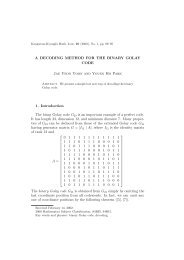
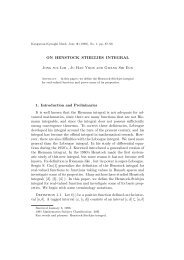
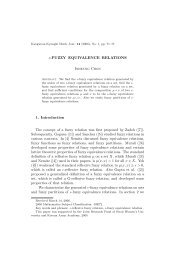
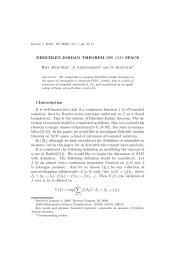

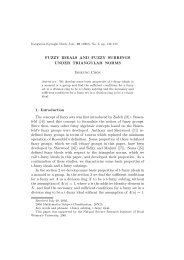
![SEMI-REGULAR po-SEMIGROUPS SK Lee J. Calais([1])](https://img.yumpu.com/46211509/1/184x260/semi-regular-po-semigroups-sk-lee-j-calais1.jpg?quality=85)
